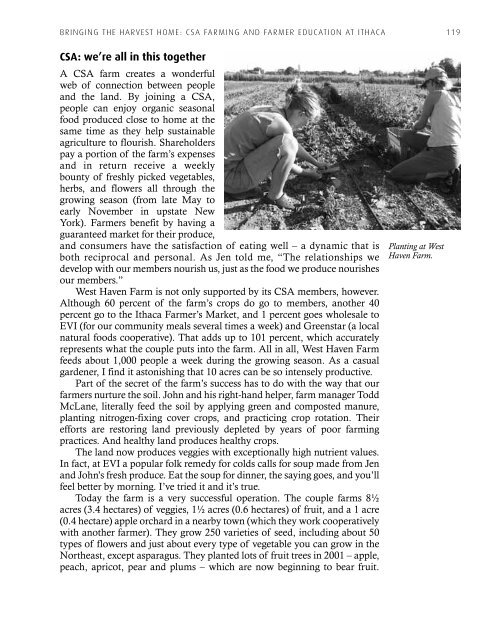Designing Ecological Habitats - Gaia Education
Designing Ecological Habitats - Gaia Education
Designing Ecological Habitats - Gaia Education
You also want an ePaper? Increase the reach of your titles
YUMPU automatically turns print PDFs into web optimized ePapers that Google loves.
inging tHe Harvest Home : csa farming anD farmer eDucation at itHaca 119<br />
CSA: we’re all in this together<br />
A CSA farm creates a wonderful<br />
web of connection between people<br />
and the land. By joining a CSA,<br />
people can enjoy organic seasonal<br />
food produced close to home at the<br />
same time as they help sustainable<br />
agriculture to flourish. Shareholders<br />
pay a portion of the farm’s expenses<br />
and in return receive a weekly<br />
bounty of freshly picked vegetables,<br />
herbs, and flowers all through the<br />
growing season (from late May to<br />
early November in upstate New<br />
York). Farmers benefit by having a<br />
guaranteed market for their produce,<br />
and consumers have the satisfaction of eating well – a dynamic that is<br />
both reciprocal and personal. As Jen told me, “The relationships we<br />
develop with our members nourish us, just as the food we produce nourishes<br />
our members.”<br />
West Haven Farm is not only supported by its CSA members, however.<br />
Although 60 percent of the farm’s crops do go to members, another 40<br />
percent go to the Ithaca Farmer’s Market, and 1 percent goes wholesale to<br />
EVI (for our community meals several times a week) and Greenstar (a local<br />
natural foods cooperative). That adds up to 101 percent, which accurately<br />
represents what the couple puts into the farm. All in all, West Haven Farm<br />
feeds about 1,000 people a week during the growing season. As a casual<br />
gardener, I find it astonishing that 10 acres can be so intensely productive.<br />
Part of the secret of the farm’s success has to do with the way that our<br />
farmers nurture the soil. John and his right-hand helper, farm manager Todd<br />
McLane, literally feed the soil by applying green and composted manure,<br />
planting nitrogen-fixing cover crops, and practicing crop rotation. Their<br />
efforts are restoring land previously depleted by years of poor farming<br />
practices. And healthy land produces healthy crops.<br />
The land now produces veggies with exceptionally high nutrient values.<br />
In fact, at EVI a popular folk remedy for colds calls for soup made from Jen<br />
and John’s fresh produce. Eat the soup for dinner, the saying goes, and you’ll<br />
feel better by morning. I’ve tried it and it’s true.<br />
Today the farm is a very successful operation. The couple farms 8½<br />
acres (3.4 hectares) of veggies, 1½ acres (0.6 hectares) of fruit, and a 1 acre<br />
(0.4 hectare) apple orchard in a nearby town (which they work cooperatively<br />
with another farmer). They grow 250 varieties of seed, including about 50<br />
types of flowers and just about every type of vegetable you can grow in the<br />
Northeast, except asparagus. They planted lots of fruit trees in 2001 – apple,<br />
peach, apricot, pear and plums – which are now beginning to bear fruit.<br />
Planting at West<br />
Haven Farm.







